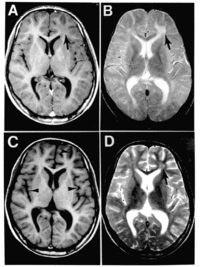
Photo from wikipedia
Background Subacute sclerosing panencephalitis (SSPE) is a fatal complication of measles. We reviewed California cases from 1998-2015 to understand risk factors for SPPE and estimate incidence. Methods SSPE cases had… Click to show full abstract
Background Subacute sclerosing panencephalitis (SSPE) is a fatal complication of measles. We reviewed California cases from 1998-2015 to understand risk factors for SPPE and estimate incidence. Methods SSPE cases had clinically compatible symptoms and measles antibody detection in cerebrospinal fluid (CSF) or medical record documentation of SSPE. Cases were identified though a state death certificate search, Centers for Disease Control and Prevention reports, or investigations for undiagnosed neurologic disease. Measles detection in CSF was performed by serology at the California Department of Public Health or at clinical laboratories. Results Seventeen SSPE cases were identified. Males outnumbered females 2.4:1. Twelve (71%) cases had a history of measles-like illness; all 12 had illness prior to 15 months of age. Eight (67%) children were exposed to measles in California. SSPE was diagnosed at a median age of 12 years (3-35 years), with a latency period of 9.5 years (2.5-34 years). Among measles cases reported to CDPH during 1988-1991, the incidence of SSPE was 1:1367 for children <5 years, and 1:609 for children <12 months at time of measles disease. Conclusions SSPE cases in California occurred at a high rate among unvaccinated children, particularly those infected during infancy. Protection of unvaccinated infants requires avoidance of travel to endemic areas, or early vaccination prior to travel at age 6-11 months. Clinicians should be aware of SSPE in patients with compatible symptoms, even in older patients with no specific history of measles infection. SSPE demonstrates the high human cost of "natural" measles immunity.
Journal Title: Clinical Infectious Diseases
Year Published: 2017
Link to full text (if available)
Share on Social Media: Sign Up to like & get
recommendations!